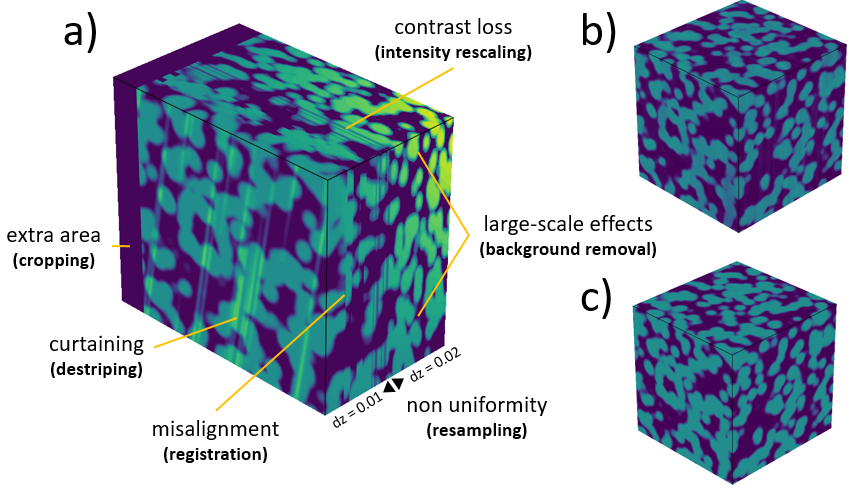PyStack3D is a package dedicated to images correction intended -for instance- to FIB-SEM stack images postprocessing before image segmentation.
The pystack3d workflow includes the following process steps which can be activated or not and executed in any order:
-
croppingto reduce the image field of view to a ROI (Region Of Interest) -
background removalto reduce from polynomial approximations artefacts issued for instance from shadowing, charging, ... -
intensity rescalingto homogenize the 'gray' intensity distribution between successive frames/slices -
registrationto correct the images misalignment due to shifting, drift, rotation, ... during the images acquisition -
destripingto minimize artefacts like stripes that can appear in some image acquisition technics -
resamplingto correct non uniform spatial steps
An additional step named cropping_final can be used to eliminate artefacts produced near the edges during the image processing or to select another ROI at the end.

a) Synthetic case illustrating the defects to be removed by PyStack3D. b) Corrected stack. c) Ground truth.

Illustration of a FIB-SEM image correction using some of the PyStack3D process steps.
pip install pystack3d
For tests and examples execution, the full pystack3d project has to be installed via git:
git clone https://github.com/CEA-MetroCarac/pystack3d.git
cd [path_to_your_pystack3d_project]
Once the project has been cloned, the python environment has to be created and completed with the pytest package (for testing):
pip install .
pip install pytest
Then the tests and the examples can be executed as follows:
pytest
cd examples
python ex_synthetic_stack.py
python ex_real_stack.py
Refer to the PyStack3D documentation.
Contributions and issue reporting are more than welcome! Please read through our Developers notes.
This work, carried out on the CEA - Platform for Nanocharacterisation (PFNC), was supported by the “Recherche Technologique de Base” program of the French National Research Agency (ANR).
In case you use the results of this code in an article, please cite:
- Quéméré P., David T. (2024). PyStack3D: A Python package for fast image stack correction. Journal of Open Source Software. (submitted)
additional citations for the destriping:
-
Pavy K., Quéméré P. (2024). Pyvsnr 2.0.0. Zenodo. https://doi.org/10.5281/zenodo.10623640
-
Fehrenbach J., Weiss P., Lorenzo C. (2012). Variational algorithms to remove stationary noise: applications to microscopy imaging. IEEE Transactions on Image Processing 21.10 (2012): 4420-4430.
additional citation for the registration:
- Thévenaz P., Ruttimann U.E., Unser M. (1998), A Pyramid Approach to Subpixel Registration Based on Intensity, IEEE Transactions on Image Processing, vol. 7, no. 1, pp. 27-41, January 1998



